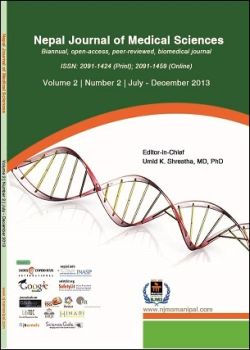An experience of femtosecond laser assisted cataract surgery in advanced brown cataracts in a tertiary Eye Center of Europe
DOI:
https://doi.org/10.3126/njms.v2i2.8953Keywords:
hard brown cataracts, femtosecond laser, mean effective phaco time, mean phaco powerAbstract
Background: To assess the results of femtosecond laser use in harder brown cataracts and share the first time experience.
Methods: Thirty eyes of thirty patients were included in this hospital based cross sectional descriptive study. The study was carried out from April, 2012 to July, 2012 in University of Bochum, Vision research center, Germany. All surgeries were performed by a single surgeon (Burkhard Dick) using the Catalys femtosecond cataract laser (Optimedica; Santa Clara, California) and a standardized “stop and chop” phaco technique with the Stellaris (Bausch + Lomb; Rochester, New York) phaco machine in venturi fluidics mode. Relevant data was entered in a proforma designed for the study and interpreted.
Results: In the study, 19 (63.3%) of the patients were females followed by males. The mean age of the patients was 74.83 years (Std. deviation 6.56). According to lenticular opacification classification system III (LOCS III); mean nuclear sclerosis was 3.9 (Std. deviation 0.80), mean absolute phaco time (APT) was 0.19 seconds (Std. deviation 0.24 seconds) mean effective phaco time (EPT) was 0.02 seconds (Std. deviation 0.04) and mean phaco power (MPP) used was 9.26% (Std. deviation 8.24). Amongst complications; remnant of anterior capsular tag and posterior capsular rupture (PCR) was noted in two patients respectively.
Conclusion: This study demonstrated that, with further innovation and optimization of technique and instruments femtosecond laser-assisted cataract surgery will become phacoless (“aphaco”) for most cataracts, whereas dense cataracts may still require the “pauci-phaco” (reduced phaco energy) technique.
Nepal Journal of Medical Sciences | Volume 02 | Number 02 | July-December 2013 | Page 114-118
Downloads
Downloads
Published
How to Cite
Issue
Section
License
Copyright © by Nepal Journal of Medical Sciences. The ideas and opinions expressed by authors of articles summarized, quoted, or published in full text in this Journal represents only opinions of authors and do not necessarily reflect the official policy of Nepal Journal of Medical Sciences or the institute with which the author(s) is (are) affiliated, unless so specified.




